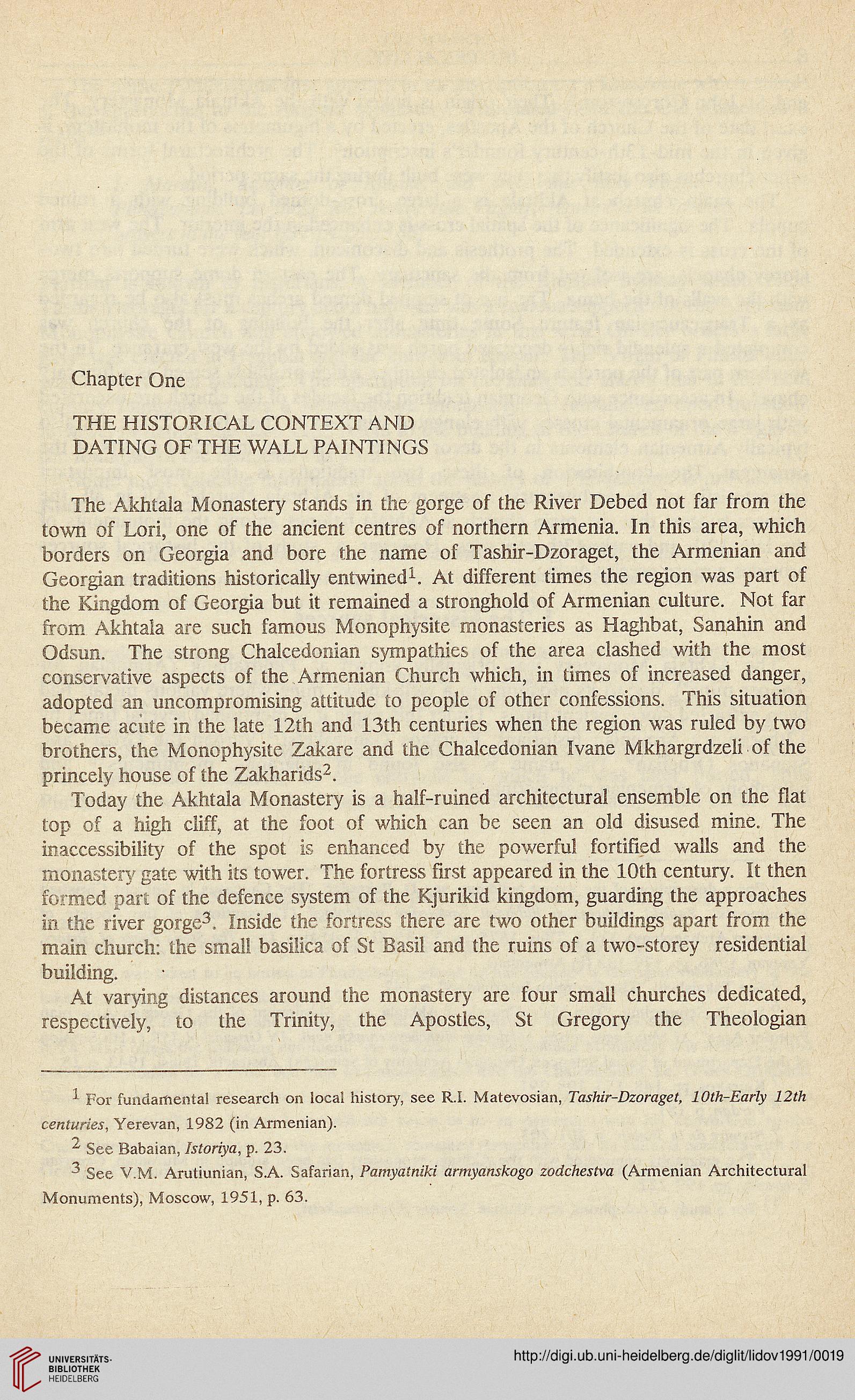Chapter One
THE HISTORICAL CONTEXT AND
DATING OF THE WALL PAINTINGS
The Akhtala Monastery stands in the gorge of the River Debed not far from the
town of Lori, one of the ancient centres of northern Armenia. In this area, which
borders on Georgia and bore the name of Tashir-Dzoraget, the Armenian and
Georgian traditions historically entwined^. At different times the region was part of
the Kingdom of Georgia but it remained a stronghold of Armenian culture. Not far
from Akhtala are such famous Monophysite monasteries as Haghbat, Sanahin and
Odsun. The strong Chalcedonian sympathies of the area clashed with the most
conservative aspects of the Armenian Church which, in times of increased danger,
adopted an uncompromising attitude to people of other confessions. This situation
became acute in the late 12th and 13th centuries when the region was ruled by two
brothers, the Monophysite Zakare and the Chalcedonian Ivane Mkhargrdzeli of the
princely house of the Zakharids^.
Today the Akhtala Monastery is a half-ruined architectural ensemble on the Hat
top of a high cliff, at the foot of which can be seen an old disused mine. The
inaccessibility of the spot is enhanced by the powerful fortified walls and the
monaster)' gate with its tower. The fortress first appeared in the 10th century. It then
formed part of the defence system of the Kjurikid kingdom, guarding the approaches
in the river gorgcT Inside the fortress there are two other buildings apart from the
main church: the small basilica of St Basil and the ruins of a two-storey residential
building.
At varying distances around the monastery are four small churches dedicated,
respectively, to the Trinity, the Apostles, St Gregory the Theologian
^ For fundamental research on local history, see R.t. Matevosian, 7'a.s/a'r-Dzoragct, rdtA-TTarZy 72ZA
cenfarZar, Yerevan, 1982 (in Armenian).
^ See Babaian, TrZorZya, p. 23.
3 See V.M. Arutiunian, S.A. Safarian, PamyatntZa ar/nyaarAogo zodcAartva (Armenian Architectural
Monuments), Moscow, 1951, p. 63.
THE HISTORICAL CONTEXT AND
DATING OF THE WALL PAINTINGS
The Akhtala Monastery stands in the gorge of the River Debed not far from the
town of Lori, one of the ancient centres of northern Armenia. In this area, which
borders on Georgia and bore the name of Tashir-Dzoraget, the Armenian and
Georgian traditions historically entwined^. At different times the region was part of
the Kingdom of Georgia but it remained a stronghold of Armenian culture. Not far
from Akhtala are such famous Monophysite monasteries as Haghbat, Sanahin and
Odsun. The strong Chalcedonian sympathies of the area clashed with the most
conservative aspects of the Armenian Church which, in times of increased danger,
adopted an uncompromising attitude to people of other confessions. This situation
became acute in the late 12th and 13th centuries when the region was ruled by two
brothers, the Monophysite Zakare and the Chalcedonian Ivane Mkhargrdzeli of the
princely house of the Zakharids^.
Today the Akhtala Monastery is a half-ruined architectural ensemble on the Hat
top of a high cliff, at the foot of which can be seen an old disused mine. The
inaccessibility of the spot is enhanced by the powerful fortified walls and the
monaster)' gate with its tower. The fortress first appeared in the 10th century. It then
formed part of the defence system of the Kjurikid kingdom, guarding the approaches
in the river gorgcT Inside the fortress there are two other buildings apart from the
main church: the small basilica of St Basil and the ruins of a two-storey residential
building.
At varying distances around the monastery are four small churches dedicated,
respectively, to the Trinity, the Apostles, St Gregory the Theologian
^ For fundamental research on local history, see R.t. Matevosian, 7'a.s/a'r-Dzoragct, rdtA-TTarZy 72ZA
cenfarZar, Yerevan, 1982 (in Armenian).
^ See Babaian, TrZorZya, p. 23.
3 See V.M. Arutiunian, S.A. Safarian, PamyatntZa ar/nyaarAogo zodcAartva (Armenian Architectural
Monuments), Moscow, 1951, p. 63.





